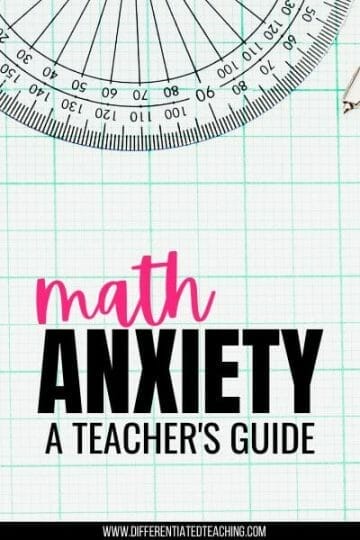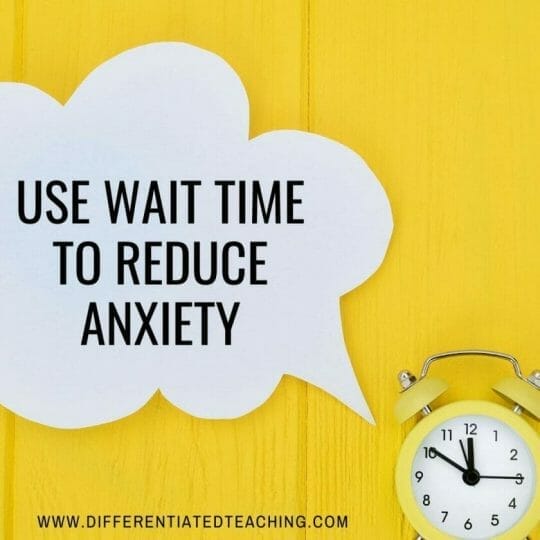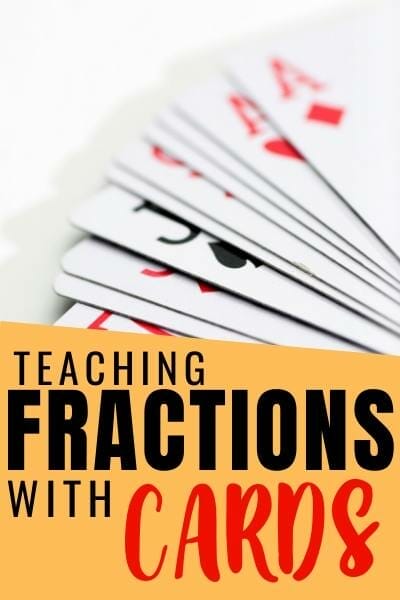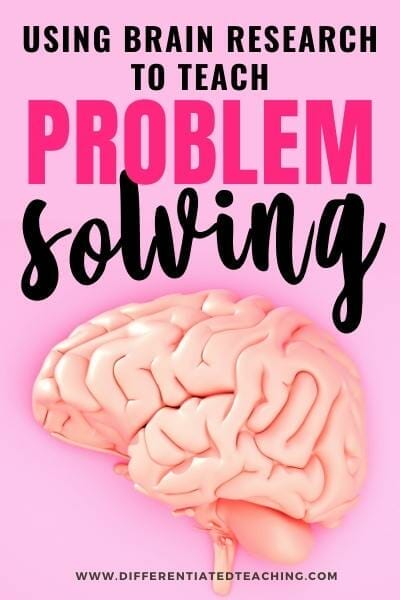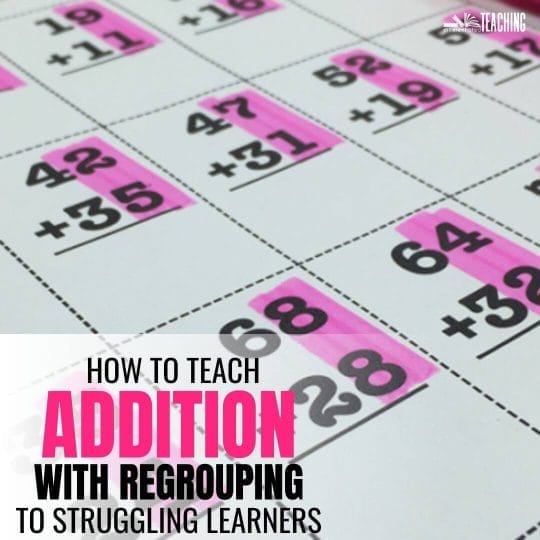Supporting Reluctant Learners with Math Anxiety
As teachers, we all know that math is essential. It is at the foundation of many of the daily activities that students will need throughout their lives. But, unfortunately, some students have a fear of math that can lead to anxiety, problems with math, and difficulty in math classes. Studies suggest that between 8% and 20% of kids (and as many as 45% of adults) experience math anxieties – defined as fear, stress, or anxiety when doing math.
These students often arrive in our classrooms loudly announcing that they are “just bad at math.” They fear getting answers wrong, worry about how others perceive them, and do their best to fly under the radar in class. This anxiety leads them to avoid activities that require quick math calculations and, without intervention, can even dissuade them from taking advanced math classes, even if they can succeed. The good news for these students is that math anxiety can be overcome. In this article, I want to share a bit of what causes math anxiety, how to recognize it in your learners, and how you can help them overcome it.
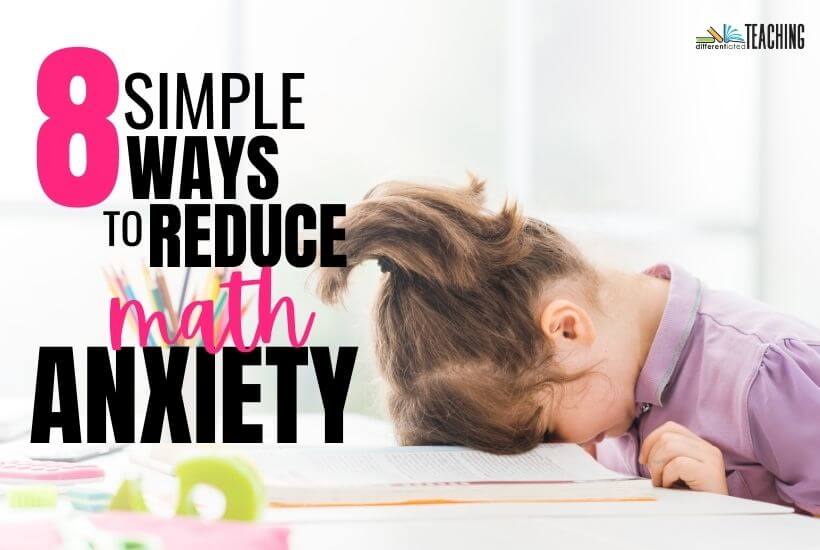
What is math anxiety & what causes it?
Math anxiety is the feeling of dread, nervousness, and worry some people experience when confronted with numbers, problem-solving, or other mathematical concepts and operations. Students with math anxiety are not necessarily bad at math, but they tend to have less confidence in their abilities. Several factors are believed to contribute to someone’s negative feelings about math, including:
- Struggles or prior negative experiences in math class
- Teaching methods or materials reliant on memorization vs. conceptual understanding
- Consistently observing peers performing more quickly or having less difficulty
- Social pressures – fear of embarrassment of being seen as “dumb” by peers
- Teachers & parent attitudes toward math and toward the student’s performance in math
That being said, the research is much less straightforward when it comes to how math anxieties develop. It’s very much a chicken-and-egg situation. While there is solid evidence that math anxiety and mathematical abilities are related, there is less clarity about which comes first.
Are students anxious about arithmetic which makes the subject more difficult to learn?
Or are students who struggle with math more likely to end up with math anxiety?
Right now, the jury is still out.
What are the signs of math anxiety?
Math anxiety can affect people of all ages, but is especially prevalent among young children. A child with math anxiety might find it hard to concentrate when solving a math problem, and while every child is different there are some commonly observed signs that a child might be experiencing math anxiety.
If you suspect that any of your students are experiencing math anxiety, it’s important to know what to look for and how to approach it so you can develop a plan that addresses their needs.
Here’s what you should look out for in the classroom:
The student avoids mathematical tasks.
For those who experience math anxiety, even thinking about the subject can be stressful. As a result, these students will go to great lengths to avoid these feelings because their body has quite literally gone into fight or flight mode and will do all it can to avoid mathematics while in this hyper-aroused state.
This can appear as repeated trips to the pencil sharpener, bathroom breaks, or misbehavior in the classroom. However, this can be the student with the tall pile of incomplete work, as many of these students do their best to avoid extra attention yet fail to complete many assignments.
The student tends to do poorly in math.
As I mentioned in the article, many students with math-related anxieties also struggle in math. Since these students tend to avoid math tasks, they will likely have had less practice than their more proficient peers. As a result, their grades are often lower. They are often your students who have had years of math interventions.
As this pattern continues, these students develop lower self-efficacy in mathematics, which only serves to perpetuate the cycle.
They freeze up when asked a question & prefer not to participate.
This often shows up in a couple of different ways. These are your students who seem to freeze whenever they’re directly asked a math-related question, and there’s actually substantial evidence that supports that this is beyond their control.
Brain research has shown that working memory resources get overworked when students experience mathematics anxiety. This means even if they can do the math, they don’t have the cognitive resources left to do it.
You might also recognize these as your more passive students. Their fear of failure and worries keep them in constant learned helplessness. Avoiding participation protects them from risking embarrassment.
Working on math-related tasks leads to overly emotional responses.
While some students freeze due to feeling anxious, others have an uncharacteristically emotional response. For example, a student who breaks down into tears or gets angry may be experiencing anxiety, especially if this behavior occurs only when doing math tasks. This is often related to these students’ internal frustration because they falsely believe everyone else can do the work more quickly and easily.
The student engages in negative self-talk.
As with other types of anxiety, negative thoughts are common among students who struggle with math anxiety. While much of this is internalized, the students are often overheard in class complaining that they hate math or aren’t good at it.
This negative self-talk frames their experiences with arithmetic – highlighting their successes as exceptions to the rule and their failures as illustrating the truth in their feelings.
How to support students with math anxiety
It’s easy to see why you might be worried about a reluctant learner struggling with math. But if our students struggle emotionally in this area, how can we help them break free from their anxieties?
Here are eight ways you can help students overcome math anxiety, so they feel more confident in the classroom.
1. Utilize think time when asking questions.
It’s perfectly acceptable to ask a question and give kids time to think before calling on someone to respond. We have lots of research that shows this helps kids learn, improves their math performance, and creates a positive classroom climate because it reduces the pressure and allows everyone time to participate instead of just the 2-3 fastest responders.
As mentioned above, research has found that math anxiety taxes the working memory system. This system is heavily utilized in math. Giving think time allows students to move past the mental block related to the overworked memory system.
In addition, think time allows all students to process the question. They can begin to think about the answer without the instant comparison between peers who may be working more quickly. Since this comparison often leads to negative self-talk for math-anxious learners, eliminating that opportunity before it arises can be helpful.
2. Start by building confidence.
There are several ways to do this. First off, if you’ve got an anxious student who freezes when asked a question in class, it can be helpful to set them up for success for a while. This means instead of calling on them randomly. Carefully select times where you can be nearly 100% certain they’ll respond correctly.
For example, after students finish working a problem in their notebook, check the student’s answer. If you know he is correct, praise him when you walk by. Tell him to raise his hand, and you’ll call on him to answer.
This strategy works for two reasons. First, it takes away the risk. The student already knows his answer is correct, so there is no risk in sharing it. Second, it prepares the student that you’ll be calling on him, so he begins to feel comfortable participating in class.
3. Focus on conceptual understanding as the foundation.
Many kids think math is really about memorizing procedures or formulas, instead of fundamentally understanding how numbers work together in interesting ways. Sometimes this is perpetuated by well-meaning teachers who are pushed into test prep as spring approaches.
It is easy to focus on having struggling learners memorize the steps and worry about understanding why later. Instead, focus on building conceptual understanding. When students understand the underlying principles of math, they are less reliant on their procedural memory.
Concept-building often begins with hands-on activities that utilize manipulatives to make math visible. This can alleviate stress because students are moving the parts and seeing how the concept looks.

It is important not to move to the abstract (or just the numbers) until the student is confident and deeply understands what they are doing. This means students need enough time to practice so that they have the opportunity to move beyond a surface-level understanding.
For younger learners: Be sure to avoid taking the manipulatives or moving toward representations, like drawings, too soon. This can cause anxiety to spike for math-anxious students.
When students only know the steps of a process, forgetting any step only exacerbates their anxiety. Understanding the underlying concepts bridges the gap to efficiently guide learners through the steps.
For more advanced students, this includes understanding why and how the formulas work more than memorizing them. Being able to understand the components
4. Use positive reinforcement.
It’s really important to avoid giving kids a negative environment regarding math. Negative self-talk is a standard part of math anxiety. Therefore, these students require consistent, external positive reinforcement to counteract the internal voice telling them they can’t be successful with math.
That can be difficult when you’re busy trying to cover a lot of material. But here’s the thing, if kids don’t have time to figure out how the math works, they’re going to feel like they’re never getting it right.
Take time to point out growth, effort, and focus on what the student did correctly over what she needs to improve. When you do have to correct or reteach, be sure to sandwich your corrections between praise to help the student internalize the positive.
In addition, purposefully partner math-anxious students with positive, encouraging peers. This can help them persist and feel less self-conscious when tackling partner or small group math tasks.
5. Approach math from a growth-mindset framework.
We know that students who believe they can improve their math skills through effort and practice generally do better in math. In fact, research has shown that teaching students a growth mindset can improve math scores.
Focus on the concept of “yet” instead of the permanency of “can’t”. This helps create a mind shift for the learner. It can also help them separate their math difficulties from their personal identity and self-concept.
Remember that you’ll also want to find ways to acknowledge that mistakes are okay. They are a normal part of the learning process. It is important to find a balance between acknowledging the students who are making progress and those who consistently excel.
6. Implement anxiety-busting strategies before tests.
Research has shown cognitive-behavioral techniques are effective in helping to reduce the effects of math anxiety on test scores. For example, journaling can help. Writing about worries before a test has been shown to reduce stress and improve test scores. Similarly, mindfulness activities and breathing exercises have both been shown to help reduce test anxiety.
There are many great options, but here’s one I like to use for elementary students.
7. Seek family support.
Another tool for supporting a student who is struggling with math anxiety is to build strong home-school connections. While this strategy is suitable for all learners, it can be beneficial for those who feel anxious or lack confidence in their academic abilities.
This connection can allow you to communicate areas where the student is doing well and areas that may benefit from additional practice. It can also be helpful because students often tell parents things they don’t mention at school and vice-versa.
While not always possible, if parents ask, one-on-one tutoring has been shown to help reduce math anxiety.
Unfortunately, you may also find that this conversation may guide you to take care in how much you share negatives about math with families. If you notice that there is a high-pressure environment at home, you may want to take care and consider how best to communicate about math to the student’s family as not to make anxieties worse.
8. Help students find the fun in mathematics.
Purposefully planning fun, low-pressure math activities is another essential aspect of helping reduce student fears. Creating positive experiences where students can be successful and find joy in mathematics helps to foster a positive association between the subject and the learner.
Games, escape rooms, and puzzles are commonly included in classrooms to review and practice essential concepts and skills. Ensuring that these are utilized so that students are working to review previously mastered materials is the most critical aspect of this strategy.
Taking control of math anxiety in the classroom
The first step to helping reluctant learners take control of their math-related anxieties is by recognizing the signs in the classroom. Teachers need to be aware of what this looks like and how they can best address it to help set these students on a path for a lifelong positive relationship with mathematics.
I hope you found some helpful strategies in this article, and if you’d like to learn more about helping engage your students with arithmetic, check these out:

